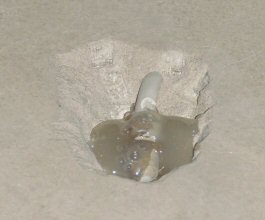
 Just as I began to pen this article I realized that my before, during and after pictures were accidentally deleted from my camera. I was able to take the replacement “after” picture to the right, but the rest will be up to your imagination. I’ll try to be vivid in the description.
Just as I began to pen this article I realized that my before, during and after pictures were accidentally deleted from my camera. I was able to take the replacement “after” picture to the right, but the rest will be up to your imagination. I’ll try to be vivid in the description.
A few weekends back we poured the second area of self leveling cement over the ThermoTile radiant heating wire mats in the basement. Prior to the pour, we secured the heating wire to the slab with hot glue every 16″ on the loop ends to ensure the wire did not protrude from the self leveling cement after the pour. Overall, the pour worked great – all the heating wires were fully encapsulated.
After the cement hardened, I noticed one small wire protruding from the surface about 3/4″. (Sorry, this is where a picture would have been helpful). The offending wire was the end of one of the temperature probes that is embedded in the cement between two parallel heating wires. The probe has leads that run back to the baseplate in the wall and then up to the thermostat.
I followed the steps below to repair the wire, which I’m sure would work just as well for a heating wire as it did for the probe. I haven’t finished step 5. I’ll fill in the hole with self leveling cement when we pour the 3rd area of the basement a few weekends from now.
Steps to Reseat the Heating Wire
1) Carefully chisel out the self-leveling mortar around the wire, ensuring the you don’t cut or nick the wire. Severing the connection in the wire will render the probe or heating element useless. This would be very costly to fix.
2) Continue chiseling out the cement out until you reach the spot on the wire that is firmly fastened to the slab. Ensure that you have created a large enough hole to refill it will self-leveling mortar or thinset easily.
3) Use hot glue to re-attach the wire to the slab.
4) Prime the area in and around the repair with the appopriate primer for your self-leveling cement (e.g. LevelQuik Primer).
5) Fill in the area with additional self-leveling cement or thinset.







Fred,
I’ll be very curious to hear how that type of retrofit radiant works for you. We have regular radiant hot water tubes in our basement slab and they work great.
Todd, thanks for the interest! Our friends have mixed opinions on whether the whole thing is a good idea. We might be paying a fortune for the energy to run the system… but Baltimore winters are VERY cold (as I’m sure you can relate to up north).